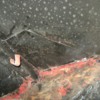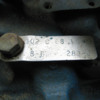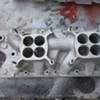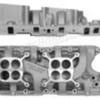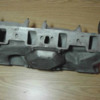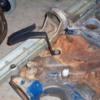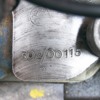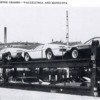Nate, here is a view from the inner fender; the spot welds are between the trapezoidal support...Lee
Wow Lee. You are posting all of these detailed pictures of the Mangusta. It's going to make me think that I actually know something about the car. 
Wow! You guys really bain bizzy here while I bain bizzy getting ready for and going to and fro Phoenix!!! 2000+ miles on the Goose! Didn't burn a drop of oil and my only complaints are the speedo is fast, and the ac fan in the cabin sucks.....!
Some points.....
289's: I think the latest car with a 289HiPo that I know of was 524 or so. Car that sold out of Nor Cal with the GT40 wheels on it...last year. These were expensive engines...why would DeTomaso continue to buy them? 302's were bone stock Mustang/Cougar stick trans engines. Minor changes done to them, like flipping the carb around! This does nothing detrimental to the engine....it's a dual plane intake....engine doesn't care... Most all originals that I have seen have the carb backwards. Holley conversions can go either way.
The car Jack mentioned is not 510, but 508, 4th-5th car built. I have seen the internals of this engine and it is ALL hipo 289 down to the dual point dist.....can't recall the date codes, but they are 67 IIRC, but windows are all early 68 dates, so this is NOT a 67.....contrary to previous owner claims. How could it have been sold in 67 if the windows were still sand!!!??
302's: 68 engines with air injection had the spark plug wire extensions screwed onto the original tabs on the valve covers. One picture somewhere above, can't quite make out the arrangement of how they were attached, but you can see the extension bracket, but these were only used in 68 that I am aware of and with the air injection. This would mean that DeT was buying engines from Ford parts dept and not from production line as someone suggested. Ford didn't sell stuff from the production line...that stuff was planned for and built for....the line. This is well known in the Ford circles..... DeT also bought industrial motors (from Euro sources!?)...painted baby poo brown/orange. These had HD water pumps with a larger center shaft....which is probably why your water pump pulley center hole is so large! Some replacement pumps will come with a bushing to take up the difference in size! Some engines had a stock Ford lower pulley, but the water pump pulley was never used on a Ford, and is why we have special water pump pulleys. To the best of my knowledge. (I scoured the books trying to find a stock water pump pulley as a replacement with no luck. Nothing in the Ford MPC matches the belt widths of the crank pulley in the way that DeT used them.....)
If 1064 had a 68 engine...which it seems like it does, the engine tag would give it away. If you can supply me with engine codes, I can decipher per the Ford parts books....should be a number 245,246 (hipo 289) or for 302's: 283 or 284 plus date codes etc. The 283/284 number is something that is listed in the books by applications. Tells you cubic inches, carb, and car line it is intended for. On a Mustang, the build sheet would have this number stamped on the paper, so the line guys knew which engine to grab.
I kept the tag for 760's engine, and first line reads 302 (displacement) C (rev?) 68 (for 1968) 1-not sure.... bottom line is 8 C or March of 68, is when it was produced, and 283-J which is the engine code and another revision number I believe. This is listed as a 1968 4V engine. If you have tags...and the numbers differ, sure would love to hear about it!!!
Spark plug wires should have been Autolite which came with the engine. 1064 also has great shots of the wire holder, to keep the wires off of the jackshaft! Problem with aftermarket manifolds is that they dropped the tab that these were mounted to, or it is under the jackshaft and interferes, so most do not have it unless they have the stock cast iron manifold! I could not put this onto my new Edelbrock intake....was pissed about that....! Watch your wires!
Would loved to have heard how DeT ordered the engines, ie minus the exhaust manifolds??? With or without clutch disc....pressure plate.....
Love the pictures of the relocated timing pointer and oil temp. Would be interesting to hear if any others have the same timing pointer or was this pointer added on by a frustrated owner!? Timing marks would have to be transferred...
Intakes: NOTHING wrong with the cast iron intake and the 1" carb spacer. Swapping to aluminum saves weight, and gains only small amount of HP. Breathing problems were more cam and exhaust port related.....getting air out.....not in.
Where it gets hazy, is after the 1100's which would have been late 69 making them, at least by US standards, 1970 models. My car, #878 has some windows dated July of 69 and others not too far off....so my car was not shipped before July. Window dates will help you decipher your car's "born on date"...or at least a "no sooner than" date! Which motors did these cars come with??? 69 302 with no air injection? 69 engines of 302 displacement were not 4V engines, unless they were a Boss, to my knowledge & the Ford master parts catalog. Some 69 Mustangs got 289's due to production prob's at the Windsor engine plant. Cougars got 351W's as smallest engine in 69.
We certainly should never have had 1970 engines in the cars, as the water pump orientation changed and would seriously mess with the large water hose routing!!! Don't ask how I know this...
If you have an original engine, date codes will help you, if you do not have the small aluminum engine tag, to figure your engine's birth month.
But, there are seemingly plenty of cars that were produced with no smog pump......indicating that the production line changed the "source" of engines from one type to another.....OR DeTomaso had Ford pull some strings to put 302 4V intakes on 69 engines...??? So, those of you with later model cars with dates from block, intake, heads, distributor, carb, and flywheel, could help decipher this issue! All of these numbers should be within about a month of each other... Smog pumps will also have dates on them, but they were not made at the casting foundry...so could differ by a wider margin. Harmonic balancers will also have a 2-3 digit date code stamped into them on the outer ring. These can vary from the castings by a couple of months. Water pumps also have dates, but these are probably LONG gone....!
Unless my bell-housing was replaced....I can find no evidence of ever supporting an air pump on the outside, and the alternator on the inside mount. No scars around the holes.....but I'd bet a dollar that someone wanged the bell-housing on something and replaced it...removed the smog pump..... oR NOT! The wiring for my alternator is extra short, with factory connections on the spades...so it was not shortened in this country..... So perhaps my car came with no smog pump already..... May never know....second owner may not recall and first owner, the dealer that sold the car is presumed passed on....at least the dealership is gone!
Water valves: NICE pictures of 1064 units! This car is a well preserved although under driven gem! Until the last of the cars finished, in Germany, I do not know of any that had heater valves connected to the front cabin! Turning the heat on or off was a fire drill! Still waiting for someone to pipe up and provide pictures....backed up by another owner's pic's! My valves (Fiat and others) were rotted to hell, caused by no ground wire to the chassis.... so I didn't install the 8 miles of extra hose, and just put ball valves up under my dash. Small PITA to get to....but you only need to crack one a little and leave it...then modulate with the other..on just a little or off. VERY easy to cook yourself out of the cabin even in the winter!
Shocks: DeCarbon was the original manufacturer of the Goose shocks, at least the rears. The rears I have are painted green, with yellow springs. Fronts were converted to Koni at some point but retained the stock silver springs.
OK, this is long...and I can't recall if I nailed everything that I wanted to mention. LOTS of GREAT pic's here guys!!!! Love it!!!
OH, Doug, I think the two lines you mentioned at the steering rack may have been for the retractable headlamps of a two headlamp car....as I do not have them present on my quad lamp car.
We really need to fix that crazy parking brake mess.....Rube Goldberg flunked this one....
Ciao!
Steve
Some points.....
289's: I think the latest car with a 289HiPo that I know of was 524 or so. Car that sold out of Nor Cal with the GT40 wheels on it...last year. These were expensive engines...why would DeTomaso continue to buy them? 302's were bone stock Mustang/Cougar stick trans engines. Minor changes done to them, like flipping the carb around! This does nothing detrimental to the engine....it's a dual plane intake....engine doesn't care... Most all originals that I have seen have the carb backwards. Holley conversions can go either way.
The car Jack mentioned is not 510, but 508, 4th-5th car built. I have seen the internals of this engine and it is ALL hipo 289 down to the dual point dist.....can't recall the date codes, but they are 67 IIRC, but windows are all early 68 dates, so this is NOT a 67.....contrary to previous owner claims. How could it have been sold in 67 if the windows were still sand!!!??
302's: 68 engines with air injection had the spark plug wire extensions screwed onto the original tabs on the valve covers. One picture somewhere above, can't quite make out the arrangement of how they were attached, but you can see the extension bracket, but these were only used in 68 that I am aware of and with the air injection. This would mean that DeT was buying engines from Ford parts dept and not from production line as someone suggested. Ford didn't sell stuff from the production line...that stuff was planned for and built for....the line. This is well known in the Ford circles..... DeT also bought industrial motors (from Euro sources!?)...painted baby poo brown/orange. These had HD water pumps with a larger center shaft....which is probably why your water pump pulley center hole is so large! Some replacement pumps will come with a bushing to take up the difference in size! Some engines had a stock Ford lower pulley, but the water pump pulley was never used on a Ford, and is why we have special water pump pulleys. To the best of my knowledge. (I scoured the books trying to find a stock water pump pulley as a replacement with no luck. Nothing in the Ford MPC matches the belt widths of the crank pulley in the way that DeT used them.....)
If 1064 had a 68 engine...which it seems like it does, the engine tag would give it away. If you can supply me with engine codes, I can decipher per the Ford parts books....should be a number 245,246 (hipo 289) or for 302's: 283 or 284 plus date codes etc. The 283/284 number is something that is listed in the books by applications. Tells you cubic inches, carb, and car line it is intended for. On a Mustang, the build sheet would have this number stamped on the paper, so the line guys knew which engine to grab.
I kept the tag for 760's engine, and first line reads 302 (displacement) C (rev?) 68 (for 1968) 1-not sure.... bottom line is 8 C or March of 68, is when it was produced, and 283-J which is the engine code and another revision number I believe. This is listed as a 1968 4V engine. If you have tags...and the numbers differ, sure would love to hear about it!!!
Spark plug wires should have been Autolite which came with the engine. 1064 also has great shots of the wire holder, to keep the wires off of the jackshaft! Problem with aftermarket manifolds is that they dropped the tab that these were mounted to, or it is under the jackshaft and interferes, so most do not have it unless they have the stock cast iron manifold! I could not put this onto my new Edelbrock intake....was pissed about that....! Watch your wires!
Would loved to have heard how DeT ordered the engines, ie minus the exhaust manifolds??? With or without clutch disc....pressure plate.....
Love the pictures of the relocated timing pointer and oil temp. Would be interesting to hear if any others have the same timing pointer or was this pointer added on by a frustrated owner!? Timing marks would have to be transferred...
Intakes: NOTHING wrong with the cast iron intake and the 1" carb spacer. Swapping to aluminum saves weight, and gains only small amount of HP. Breathing problems were more cam and exhaust port related.....getting air out.....not in.
Where it gets hazy, is after the 1100's which would have been late 69 making them, at least by US standards, 1970 models. My car, #878 has some windows dated July of 69 and others not too far off....so my car was not shipped before July. Window dates will help you decipher your car's "born on date"...or at least a "no sooner than" date! Which motors did these cars come with??? 69 302 with no air injection? 69 engines of 302 displacement were not 4V engines, unless they were a Boss, to my knowledge & the Ford master parts catalog. Some 69 Mustangs got 289's due to production prob's at the Windsor engine plant. Cougars got 351W's as smallest engine in 69.
We certainly should never have had 1970 engines in the cars, as the water pump orientation changed and would seriously mess with the large water hose routing!!! Don't ask how I know this...
If you have an original engine, date codes will help you, if you do not have the small aluminum engine tag, to figure your engine's birth month.
But, there are seemingly plenty of cars that were produced with no smog pump......indicating that the production line changed the "source" of engines from one type to another.....OR DeTomaso had Ford pull some strings to put 302 4V intakes on 69 engines...??? So, those of you with later model cars with dates from block, intake, heads, distributor, carb, and flywheel, could help decipher this issue! All of these numbers should be within about a month of each other... Smog pumps will also have dates on them, but they were not made at the casting foundry...so could differ by a wider margin. Harmonic balancers will also have a 2-3 digit date code stamped into them on the outer ring. These can vary from the castings by a couple of months. Water pumps also have dates, but these are probably LONG gone....!
Unless my bell-housing was replaced....I can find no evidence of ever supporting an air pump on the outside, and the alternator on the inside mount. No scars around the holes.....but I'd bet a dollar that someone wanged the bell-housing on something and replaced it...removed the smog pump..... oR NOT! The wiring for my alternator is extra short, with factory connections on the spades...so it was not shortened in this country..... So perhaps my car came with no smog pump already..... May never know....second owner may not recall and first owner, the dealer that sold the car is presumed passed on....at least the dealership is gone!
Water valves: NICE pictures of 1064 units! This car is a well preserved although under driven gem! Until the last of the cars finished, in Germany, I do not know of any that had heater valves connected to the front cabin! Turning the heat on or off was a fire drill! Still waiting for someone to pipe up and provide pictures....backed up by another owner's pic's! My valves (Fiat and others) were rotted to hell, caused by no ground wire to the chassis.... so I didn't install the 8 miles of extra hose, and just put ball valves up under my dash. Small PITA to get to....but you only need to crack one a little and leave it...then modulate with the other..on just a little or off. VERY easy to cook yourself out of the cabin even in the winter!
Shocks: DeCarbon was the original manufacturer of the Goose shocks, at least the rears. The rears I have are painted green, with yellow springs. Fronts were converted to Koni at some point but retained the stock silver springs.
OK, this is long...and I can't recall if I nailed everything that I wanted to mention. LOTS of GREAT pic's here guys!!!! Love it!!!
OH, Doug, I think the two lines you mentioned at the steering rack may have been for the retractable headlamps of a two headlamp car....as I do not have them present on my quad lamp car.
We really need to fix that crazy parking brake mess.....Rube Goldberg flunked this one....
Ciao!
Steve
It would be interesting to compare engine build tags on the 'goose.
I'm thinking that DT may have bought the 302's all at the same time, from the same engine run.
They probably had their own account ID # in the Ford Parts system.
The problem I have with that is how would they have known how many engines to purchase if these cars were built only on special order well into the '71 model year, and would the '68 302 4V still have been serviced then?
I'm pretty sure that the engine as an assembly would have included the exhaust manifolds, flywheel, clutch and bell.
Not sure about the air cleaner.
The yellow top coil would have been installed on the engine too along with the spark plug wires and spark plugs.
An engine assembly from Ford is ready to drop in and run.
All 68 302 4v manual trans engines had air injection installed.
The automatics did not. Maybe DT ordered engines as closely as possible to what they wanted and if that was an automatic trans car, just change out the flex plate to a manual flywheel and clutch?
I'm thinking that DT may have bought the 302's all at the same time, from the same engine run.
They probably had their own account ID # in the Ford Parts system.
The problem I have with that is how would they have known how many engines to purchase if these cars were built only on special order well into the '71 model year, and would the '68 302 4V still have been serviced then?
I'm pretty sure that the engine as an assembly would have included the exhaust manifolds, flywheel, clutch and bell.
Not sure about the air cleaner.
The yellow top coil would have been installed on the engine too along with the spark plug wires and spark plugs.
An engine assembly from Ford is ready to drop in and run.
All 68 302 4v manual trans engines had air injection installed.
The automatics did not. Maybe DT ordered engines as closely as possible to what they wanted and if that was an automatic trans car, just change out the flex plate to a manual flywheel and clutch?
Re. the tubes Doug mentioned going to the steering rack, I was assuming he was refering to the 2 long bent pipes that are 'integral' to the chassis on later cars - welded in many places, at least - delivering hot water to/from the heater core. (The angle of one of Lee's photos does makes it look like they go into the steering rack). Steve's comments got me looking at early chassis photos and sure enough these pipes appear on later cars only. The change probably coincided with other major chassis updates (e.g., elimination of the circular opening seen on the front of the early spines) but I need to research this more before speculating!
Here's the tag on my 1970 Goose.
Attachments
My car, 8MA670, has two white plastic tubes that are 2 1/2 inches in diameter that run from the front at the end of the frame rails back to the end of the frame rails in back. Nothing is in them or ever was. I think they were put there to connect the front air intakes under the headlamps, 2 1/2 inch round outlet also, to them with hose. The outlet in the back could then have hose connected to them to direct air to the rear brakes.
Just a theory.
Any one else have any ideas?
Dick Ruzzin
DICK RUZZIN
Just a theory.
Any one else have any ideas?
Dick Ruzzin
DICK RUZZIN
Lee,
You are posting pic's from two different cars right??? 1046 and 1076? The latter being your car under works right now?
The mirror pic that you posted from black car... My car has the same mirror on the LH side. Originally came with two but prev owner decided on one, mounted on side of door vs top of fenders where they were useless. Popular rumor has it that the cars came without mirrors...dealers added them at will.
Denis- the valve cover oil filler cap that you have on your extra set of valve covers is a 74 or so version. 68 version would be a 2" tall version with a 90 degree fitting on the top I believe. No pictures that I can find of the original.....but shouldn't have a PCV valve in it. Look at stock Mustang version for 68 in the catalogs...you'll see what I mean.
Skid plate: owner of 6K mile Goose from PA that went to Europe a while back told me that when he went to trade in his 275 Ferarri, that he couldn't have the Goose until a skid plate was installed......and they were waiting for them to arrive, or some such BS. This skid plate pictured appears to be similar to another that I have seen in pics. Unfortunately, I had such a woody looking at this magnificent car, that I forgot completely to get down on the ground and take a picture of it.... This was basically the only other Goose that I had yet to see in person, and I went from my "box of parts" car to this museum piece....so was a bit overwhelmed. Same thing with the factory car when I visited....
I went back and looked at the two bent tubes for the heaters...mine seem different as does a little of the sheet metal work in that area. This car has less open spaces....it might seem.
My car had been missing the small square cover that you see in the center of the trunk area, that closes off the center spine to hot air hitting the shifter etc. DO NOT leave this cover off or you will regret it.....we're talking smoking hot shifter and ashtray......
Doug, that dual quad SBF setup just gave me another woody.....I'm so easy! Where did you get the spacers for the air cleaner? ...and does it fit under the hood? Is this a different version than the TA cars (Cougars) were going to use (in 67), ie high riser vs a low dual plane? Stop it...you're making me drool all over my keyboard now....
I'm going to start a parking brake thread...I like the large metal pulley! The parts books says that this pulley is a Fiat part...850 or 500...can't be sure, but mine have been replaced or are made of plastic....and I HATE the fact that the cable runs down the chassis unguarded.....! Stupid...
Ciao!
Steve
You are posting pic's from two different cars right??? 1046 and 1076? The latter being your car under works right now?
The mirror pic that you posted from black car... My car has the same mirror on the LH side. Originally came with two but prev owner decided on one, mounted on side of door vs top of fenders where they were useless. Popular rumor has it that the cars came without mirrors...dealers added them at will.
Denis- the valve cover oil filler cap that you have on your extra set of valve covers is a 74 or so version. 68 version would be a 2" tall version with a 90 degree fitting on the top I believe. No pictures that I can find of the original.....but shouldn't have a PCV valve in it. Look at stock Mustang version for 68 in the catalogs...you'll see what I mean.
Skid plate: owner of 6K mile Goose from PA that went to Europe a while back told me that when he went to trade in his 275 Ferarri, that he couldn't have the Goose until a skid plate was installed......and they were waiting for them to arrive, or some such BS. This skid plate pictured appears to be similar to another that I have seen in pics. Unfortunately, I had such a woody looking at this magnificent car, that I forgot completely to get down on the ground and take a picture of it.... This was basically the only other Goose that I had yet to see in person, and I went from my "box of parts" car to this museum piece....so was a bit overwhelmed. Same thing with the factory car when I visited....
I went back and looked at the two bent tubes for the heaters...mine seem different as does a little of the sheet metal work in that area. This car has less open spaces....it might seem.
My car had been missing the small square cover that you see in the center of the trunk area, that closes off the center spine to hot air hitting the shifter etc. DO NOT leave this cover off or you will regret it.....we're talking smoking hot shifter and ashtray......
Doug, that dual quad SBF setup just gave me another woody.....I'm so easy! Where did you get the spacers for the air cleaner? ...and does it fit under the hood? Is this a different version than the TA cars (Cougars) were going to use (in 67), ie high riser vs a low dual plane? Stop it...you're making me drool all over my keyboard now....
I'm going to start a parking brake thread...I like the large metal pulley! The parts books says that this pulley is a Fiat part...850 or 500...can't be sure, but mine have been replaced or are made of plastic....and I HATE the fact that the cable runs down the chassis unguarded.....! Stupid...
Ciao!
Steve
quote:Originally posted by Mangusta:
Doug, that dual quad SBF setup just gave me another woody.....I'm so easy! Where did you get the spacers for the air cleaner? ...and does it fit under the hood? Is this a different version than the TA cars (Cougars) were going to use (in 67), ie high riser vs a low dual plane? Stop it...you're making me drool all over my keyboard now....
Ciao!
Steve
Spacers are by Edelbrock. Yes the air cleaner fits under the hood.
That is the Blue Thunder repro of the original Ford high rise manifold.
The '67 Trans-Am Coupes used the C6OA lettered 2x4. There were only 2 '68 302TP's both run by Shelby.
If you look at them vs. this one, those runners are rounded and flow more. It was made for the GT40 heads, C6FE, C7FE casting numbers.
According to Randy Gillis, flow testing showed that mine, the rectangular runners couldn't flow what the "as cast" GT40 heads did.
He also said that flow tested showed that no matter who ported the standard heads (like my 302 4v's) they couldn't be made to flow what the as cast GT40 heads did.
So Ford redesigned the manifold with round runners that flow matched the heads.
For me, this manifold with (if you noticed) the '85 "Motorcraft (Holleys)", converted to Holley side hung bowls, work NICE!
I think the secret is the 427 Ford linkage that makes the carbs progressive.
The fact that the main jets are #59's says something right there?
This set up gives you around 25 mpg simply because the linkage has you running on the primary/primary until about 3,200rpm's.
Now this is also a 347 stroker built into the original J code heads, balancer, block and distributor. Same as a 'goose.
The heads were race ported and the manifold was matched to it, 1.94 intakes and 1.60 exhausts and the thing just boogies!
This would be such a nice set up in a 'goose, except maybe for all of the bent chassis components it would cause?
This is the 67 289 Trans Am manifold. See the rounded runners? Now look at mine with the rectangular runners.
Attachments
This is it.
According to Randy, the set up makes about the same HP as the single 1 x 4 Holley on the Cobra high rise but having driven both, this set up makes more torque because of the progressiveness of the linkage.
In T/A, the 2 x4 's were also the set up of preference vs. the single 4 Holley so that tells ME allot right there.
Period advertising states a 50hp gain over a single 4v. That doesn't seem to be supported by current thinking SO I can't prove it's 50, but sumpin' goin' on there? Yup!
You have to drive this thing to understand. You can't unless you do.
This one's reproduced (Blue Thunder) and the C6OA isn't. Chances are unless you are using the old matching GT40 heads, there won't be much of a difference? That was my thinking anyway?
When the secondaries open, there is this WHOMP RACKET that they create.
According to Randy, the set up makes about the same HP as the single 1 x 4 Holley on the Cobra high rise but having driven both, this set up makes more torque because of the progressiveness of the linkage.
In T/A, the 2 x4 's were also the set up of preference vs. the single 4 Holley so that tells ME allot right there.
Period advertising states a 50hp gain over a single 4v. That doesn't seem to be supported by current thinking SO I can't prove it's 50, but sumpin' goin' on there? Yup!
You have to drive this thing to understand. You can't unless you do.
This one's reproduced (Blue Thunder) and the C6OA isn't. Chances are unless you are using the old matching GT40 heads, there won't be much of a difference? That was my thinking anyway?
When the secondaries open, there is this WHOMP RACKET that they create.
Attachments
Port view of 67 T/A manifold. Ports match up to GT40 heads which "resemble" 69-70 351W heads.
This is not the Tunnel port manifold.
This is not the Tunnel port manifold.
Attachments
This is the tunnel port 302.
Attachments
OK, here is a little more engine marking info from a couple of cars...
0760 manifold stamped as 302/96
0652......................302/41...the Kylie car
0994 & 0996...fitted with a Torker so no ##'s
Here is a pic of the spark plug wire hanger that Roger B. of the UK made for me, modeled after what was on 0760. Just flat stock, I put the heat shrink in it...didn't shrink it...
This is a proper 68 "C8ZE" intake that would be correct on the 302 cars. Early 289's probably have a "C6OE" or perhaps even "C5OE" depending....
Steve
0760 manifold stamped as 302/96
0652......................302/41...the Kylie car
0994 & 0996...fitted with a Torker so no ##'s
Here is a pic of the spark plug wire hanger that Roger B. of the UK made for me, modeled after what was on 0760. Just flat stock, I put the heat shrink in it...didn't shrink it...
This is a proper 68 "C8ZE" intake that would be correct on the 302 cars. Early 289's probably have a "C6OE" or perhaps even "C5OE" depending....
Steve
Attachments
quote:Originally posted by LeeA:
I thought the skid plate was home-made, but I've seen other pictures of one like this so maybe it was common. Workmanship was quite high...
Interesting. You may be onto something about the skid plate. here is a pic from my stash. For many years, I have been "right click>save" every picture from ebay or the internet. This is from a rustbucket on ebay many years ago.
Attachments
Wow! What a pile of poo! Can't recognize some of that stuff!
I've always wondered about the plethora of extra holes in my chassis at various points....which could have been from a skid plate.... I wonder where it is today.....!
Steve
I've always wondered about the plethora of extra holes in my chassis at various points....which could have been from a skid plate.... I wonder where it is today.....!
Steve
quote:Originally posted by JMM3:quote:Originally posted by LeeA:
I thought the skid plate was home-made, but I've seen other pictures of one like this so maybe it was common. Workmanship was quite high...
Interesting. You may be onto something about the skid plate.
I seem to recall stories about the Mangusta having ground clearance issues with the bell housing. Maybe it was being mentioned in some of the early magazine road tests?
A skid plate seems like cheap insurance considering what you could break (the ZF) without one?
Steve, where are the stampings on the manifolds you are mentioning?
Those stampings appear to be on that giant boss at the back of the intake, with the three holes on it, where the jackshaft bracket anchors. I think the thermactor air valves sat there on some cars.....but it is an odd chunk-o-cast iron there....
Ground clearance...I think it all had to do with springs and shocks. My car had the originals and as a result, my bellhousing is about 1/2" shorter than stock....! Missing material! Ain't there no more! Done ground off! Could have been replaced once.....by now.....
Once I put on higher rate springs, and actual shocks with seals in them...WOW! Car went from feeling like a VW bug with 6 people in the back, to feeling like a real car! No more ground clearance issues....but watch out for speed bumps....they can be hazardous if you aren't ready for them!!! Stupid speed bumps....
The stock shocks were gas originally...now not gas...not hardly a shock! There was nothing to prevent the car from squatting down when you moved thru a depression in the roadway. First time on the way to Vegas, not even 15 miles from home, I hit a bridge transition joint and scraped my block plate! Actually bent it back to where it was before I straightened it....! Rest of the trip was "pucker factor on high(!)" when ever a bridge joint came up....
Found some new shocks as soon as I got back from that trip!
But yes, I have heard of guys wiping out their bellhousing AND the front of the ZF case!!! OUCH! However with new shocks, and a reasonable right height set (no roller skate tires here guys..!), one should be fine just about anywhere today!
Of course, the cars in the magazine articles could have been dragging their skid plates too!!!
Ground clearance...I think it all had to do with springs and shocks. My car had the originals and as a result, my bellhousing is about 1/2" shorter than stock....! Missing material! Ain't there no more! Done ground off! Could have been replaced once.....by now.....
Once I put on higher rate springs, and actual shocks with seals in them...WOW! Car went from feeling like a VW bug with 6 people in the back, to feeling like a real car! No more ground clearance issues....but watch out for speed bumps....they can be hazardous if you aren't ready for them!!! Stupid speed bumps....
The stock shocks were gas originally...now not gas...not hardly a shock! There was nothing to prevent the car from squatting down when you moved thru a depression in the roadway. First time on the way to Vegas, not even 15 miles from home, I hit a bridge transition joint and scraped my block plate! Actually bent it back to where it was before I straightened it....! Rest of the trip was "pucker factor on high(!)" when ever a bridge joint came up....
Found some new shocks as soon as I got back from that trip!
But yes, I have heard of guys wiping out their bellhousing AND the front of the ZF case!!! OUCH! However with new shocks, and a reasonable right height set (no roller skate tires here guys..!), one should be fine just about anywhere today!
Of course, the cars in the magazine articles could have been dragging their skid plates too!!!
quote:Originally posted by Mangusta:
Of course, the cars in the magazine articles could have been dragging their skid plates too!!!
Never saw a magazine editor that could double as a jockey.
it is my guess that original Mangusta motors were stamped like this one. At this time I only have a few examples, not quite enough to establish a pattern or garantee that they were all done.
Attachments
Steve, my conclusion is that the correct mirror for the Mangusta was 'none,' the most convincing picture is this picture of the transporter of Wyss's "DeTomaso Automobiles.' In the whole chapter on the Goose, the only mirrors on a Goose were along with the head scoop added to one-off roadster--the other pics in the factory showed no mirrors...
I've had this book for almost 30 years, and still remember reading about that Chevy-powered goose sent to GM and some guy kind named Dick Ruzzin who ended up with the car...amazing story to be told, I think (not just about the purchase but the keeping all this time..)--Lee
I've had this book for almost 30 years, and still remember reading about that Chevy-powered goose sent to GM and some guy kind named Dick Ruzzin who ended up with the car...amazing story to be told, I think (not just about the purchase but the keeping all this time..)--Lee
Attachments
Add Reply
Sign In To Reply


